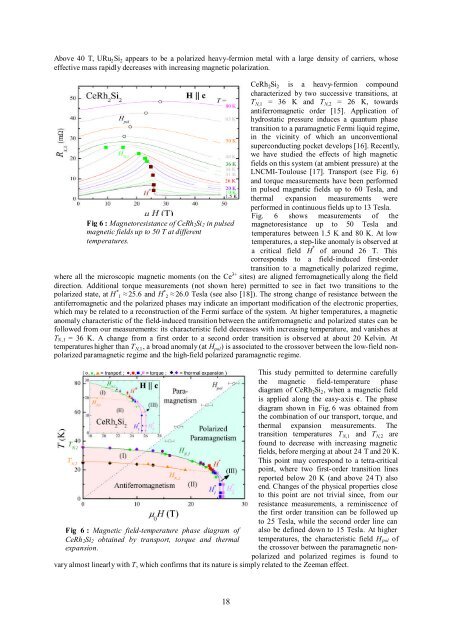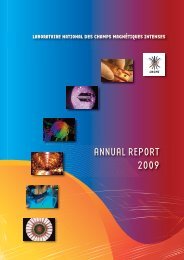Laboratoire National des Champs Magnétiques Pulsés CNRS – INSA
Laboratoire National des Champs Magnétiques Pulsés CNRS – INSA
Laboratoire National des Champs Magnétiques Pulsés CNRS – INSA
Create successful ePaper yourself
Turn your PDF publications into a flip-book with our unique Google optimized e-Paper software.
Above 40 T, URu 2Si 2 appears to be a polarized heavy-fermion metal with a large density of carriers, whose<br />
effective mass rapidly decreases with increasing magnetic polarization.<br />
Fig 6 : Magnetoresistance of CeRh2Si2 in pulsed<br />
magnetic fields up to 50 T at different<br />
temperatures.<br />
18<br />
CeRh 2Si 2 is a heavy-fermion compound<br />
characterized by two successive transitions, at<br />
T N,1 = 36 K and T N,2 = 26 K, towards<br />
antiferromagnetic order [15]. Application of<br />
hydrostatic pressure induces a quantum phase<br />
transition to a paramagnetic Fermi liquid regime,<br />
in the vicinity of which an unconventional<br />
superconducting pocket develops [16]. Recently,<br />
we have studied the effects of high magnetic<br />
fields on this system (at ambient pressure) at the<br />
LNCMI-Toulouse [17]. Transport (see Fig. 6)<br />
and torque measurements have been performed<br />
in pulsed magnetic fields up to 60 Tesla, and<br />
thermal expansion measurements were<br />
performed in continuous fields up to 13 Tesla.<br />
Fig. 6 shows measurements of the<br />
magnetoresistance up to 50 Tesla and<br />
temperatures between 1.5 K and 80 K. At low<br />
temperatures, a step-like anomaly is observed at<br />
a critical field H * of around 26 T. This<br />
corresponds to a field-induced first-order<br />
transition to a magnetically polarized regime,<br />
where all the microscopic magnetic moments (on the Ce 3+ sites) are aligned ferromagnetically along the field<br />
direction. Additional torque measurements (not shown here) permitted to see in fact two transitions to the<br />
polarized state, at H * 1 ≈25.6 and H * 2 ≈26.0 Tesla (see also [18]). The strong change of resistance between the<br />
antiferromagnetic and the polarized phases may indicate an important modification of the electronic properties,<br />
which may be related to a reconstruction of the Fermi surface of the system. At higher temperatures, a magnetic<br />
anomaly characteristic of the field-induced transition between the antiferromagnetic and polarized states can be<br />
followed from our measurements: its characteristic field decreases with increasing temperature, and vanishes at<br />
TN,1 = 36 K. A change from a first order to a second order transition is observed at about 20 Kelvin. At<br />
temperatures higher than T N,1, a broad anomaly (at H pol) is associated to the crossover between the low-field nonpolarized<br />
paramagnetic regime and the high-field polarized paramagnetic regime.<br />
Fig 6 : Magnetic field-temperature phase diagram of<br />
CeRh2Si2 obtained by transport, torque and thermal<br />
expansion.<br />
This study permitted to determine carefully<br />
the magnetic field-temperature phase<br />
diagram of CeRh 2Si 2, when a magnetic field<br />
is applied along the easy-axis c. The phase<br />
diagram shown in Fig. 6 was obtained from<br />
the combination of our transport, torque, and<br />
thermal expansion measurements. The<br />
transition temperatures T N,1 and T N,2 are<br />
found to decrease with increasing magnetic<br />
fields, before merging at about 24 T and 20 K.<br />
This point may correspond to a tetra-critical<br />
point, where two first-order transition lines<br />
reported below 20 K (and above 24 T) also<br />
end. Changes of the physical properties close<br />
to this point are not trivial since, from our<br />
resistance measurements, a reminiscence of<br />
the first order transition can be followed up<br />
to 25 Tesla, while the second order line can<br />
also be defined down to 15 Tesla. At higher<br />
temperatures, the characteristic field Hpol of<br />
the crossover between the paramagnetic nonpolarized<br />
and polarized regimes is found to<br />
vary almost linearly with T, which confirms that its nature is simply related to the Zeeman effect.







